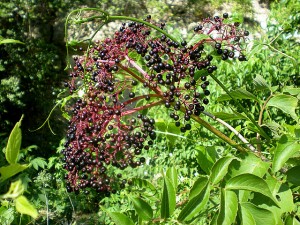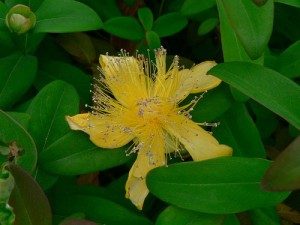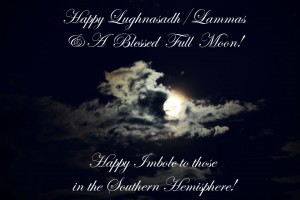Archive for August, 2012
Happy Friday!
Friday, August 31st, 2012Medicinal Monday – Black Elder
Monday, August 13th, 2012Black Elder
Botanical Name: Sambucus Nigra

Photo by Vietnam Plants & America plants
Plant Facts:
- It is a member of the honeysuckle family and can grow to a height of 33 ft.
- The Elder is sweet smelling and spicy, but the somewhat bitter tasting flowers produces blackish-purple fruits with an aromatic, tart taste.
- The stalk and branches contain a white, fluffy pulp.
Origin:
- Native to Europe, North Africa and western and central Asia, it thrives throughout lowland forests and along roads and fences and often found in farmhouse gardens.
Parts Used:
- The flowers and ripe berries are used medicinally.
- Harvest as the plant begins to blossom.
Components:
- The black elder flowers contain flavonoids, rutin, mucins and tannins and a large portion of organic acids and calcium.
- The berries contain fruit acids, vitamins B and C and folic acid, as well as essential oils.
Indications:
- Also described as a “complete medicine chest”, black elder induces perspiration.
- Take in the form of a hot drink when you have a feverish cold.
- Elder also promotes expectoration, which makes it a good treatment for coughing and bronchitis.
- The pulps of the berry and the freshly pressed juice have a diuretic and laxative effect on the body.
- Avoid the red berry species of elder, as it can irritate the digestive system and make you feel nauseous.
Types of Applications
Tea flowers:
- Pour 1 cup of boiling water over 2 large tsp. of dried elder flowers.
- Strain after 10 min.
- Drink 1-2 cups of freshly prepared tea several times, daily.
Tea from berries:
- Add enough cold water to cover approximately 2 large tsp. of dried elder berries and allow to stand for several minutes.
- Slowly bring the water-berry mixture to a simmer.
- Simmer for 10min., strain and drink.
Juice, syrup:
- Take the stems from 2 lb. of ripe berries.
- Squeeze the juice from the berries into a saucepan, add about 1 lb. of sugar.
- Boil for 5 min.
- Skim the foam from the surface, fill canning jars with the syrup and seal white hot.
- Prepared syrup is also available from pharmacies and health food stores.
- To prevent or to treat a cold, drink the heated juice or syrup dissolved in hot water.
Puree:
- Boil about 1 lb. of ripe elderberries with 1 cup of water and 2 diced apples.
- Put through a sieve and sweeten to taste.
References:
- The Complete Guide to Natural Healing
Note: Consult with a Physician or certified herbologist if you are seeking medical remedies. The information is not intended as medical advice. PagansWorld.org is not liable for the misuse of the herb listed above.
Thanks for stopping by! Well wishes to you all, have a great day!
Lisa
Friday’s Food For Thought – Macaroni & Cheese Casserole
Friday, August 10th, 2012Macaroni & Cheese Casserole
- 1 pkg. or 1 box of shells
- 8 tbsp. butter
- 8 tbsp. flour
- 5 c. milk
- 4 cups (16 ounces) shredded cheddar cheese
- 1/2 tsp. garlic salt
- 2 tsp. prepared mustard
- 2 tsp. salt
- 1/2 tsp. pepper
- Bread crumbs for topping
- Preheat the oven to 350 degrees F.
- Cook the pasta according to the package directions. Drain and set aside.
- In a large saucepan over medium heat, melt the butter. Whisk in the flour, then add the garlic salt, salt and pepper. Gradually whisk in the milk. Cook, stirring constantly, until the sauce thickens and the mixture begins to boil. Add the cheese and stir until the cheese is melted. Add the cooked pasta and stir to coat the pasta.
- Pour the mixture into a 9×13-inch baking dish.
- Bake for 25 minutes, then Sprinkle with bread crumbs. Cook an additional 20 minutes or until golden and bubbly. Let stand 10 minutes and serve.
Enjoy! Have a great weekend!
Lisa
News & Submissions 8/07/2012
Tuesday, August 7th, 2012Archaeology:
A ROMAN SHIPWRECK IN THE ANCIENT PORT OF ANTIBES
A team of archaeologists from Inrap have uncovered a Roman shipwreck in southern France, in what was once part of the bustling ancient port of Antibes.
Antibes was known as Antipolis, a Greek colony originally founded by the Phoenicians of Massalia. The date of its origin is uncertain, but situated on the coast of Provence, Antipolis occupied a privileged position on the sea routes linking Marseilles to the Italian coast and contained a natural harbour – Anse Saint-Roch – which protected shipping from prevailing winds. Read full story from pasthorizonspr.com
News:
Possible da Vinci painting found in Scottish farmhouse; could be worth $150 million
Fiona McLaren, 59, had kept an old painting in her Scottish farmhouse for decades. She reportedly didn’t think much of the painting, which had been given to her as a gift by her father. But after she finally decided to have the painting appraised, some experts are speculating that it may in fact be a 500-year-old painting by Leonardo da Vinci and potentially worth more than $150 million. Read full story from yahoo.com
Paranormal:
Witch Claims That The Loch Ness Monster Is Actually A Ghost
Kevin Carlyon, a ‘white witch’ and official ‘Protector of Loch Ness and the Loch Ness Creature’ is planning on holding a mass seance at the famous Scottish site in order to make contact with ‘Nessie’ who he believes is a ghost.
Carylon named himself as protector of Nessie after he cast a spell over Loch Ness which would prevent Swedish ‘monster hunter’ Jan Sundberg from capturing the mythical beast when he visited the Loch in 2001 on a Nessie hunt. The pair have since traded insults via email in an ongoing feud which lead to Sundberg threatening to cut Carylon an extra “asshole” and shove his head through it. Carylon responded by outing Sundberg as a convicted child molester. Read full story from themorningstarr.co.uk
Former owner of haunted Oaklands Mansion identifies himself in EVP
Oaklands Mansion in Laurel, MD, dates from 1732 and was once a prosperous plantation on over 1,000 acres. Through the years, it’s sheltered a number of different families. The Staggers family purchased it in the 1920’s and it’s still owned by a descendant today.
Media:
Explaining Sikhism (Source: CNN)
Pat Robertson Blames Atheists for Sikh Temple Shooting (Source: YouTube – RWWblog)
Close-knit mosque community shaken by fire (Source: CNN)
Blogspot:
- The Deepest Well – Tarot Tuesday/Etched in Stone?
- Patti Wigington – Jumping the Broom: Besom Weddings
- The Secret Life of the American Working Witch – A Love Note to the Sikh Community
- Unreasonable Faith – Ladies and Gentleman, Jack Schaap
Feel free to leave comments regarding the articles posted.
If you’re interested in guest blogging or would like to submit an article or event, contact me at pagansworld.org@gmail.com.
Thanks for stopping by! Well wishes to you all, have a great day!
Lisa
Medicinal Monday – St. John’s Wort
Monday, August 6th, 2012St. John’s Wort
Botanical Name: Hypericum perforatum
Characteristics:
- Its small, bright yellow flowers consist of five petals with long, feathery stamens at the center. The slender, oval leaves grow in opposite pairs. If held up to the light, the leaves often appear to be perforated
Uses:
- The fresh flowers can be used to make an oil that has proved particularly curative for skin problems, bruises and rheumatic ailments.
- St. John’s wort extracts improves mood, and decreases anxiety and insomnia related to depression.
- Some research shows that a combination of St. John’s wort, plus black cohosh can help improve menopausal symptoms.
- It may also decrease alcohol intake. The constituent hyperforin, has been said to decrease alcohol consumption.
- When the oil is rubbed onto the belly and breasts during pregnancy it can help prevent stretch marks, and is useful to treat hemorrhoids and aching, swollen veins that can occur during pregnancy.
- The aerial parts of the plant can be cut and dried for use in herbal tea.
Gardening tips:
- Plant in a sunny, warm location, but will grow in partial shade.
- Likes well drained soil, not too moist, with high humus content.
- Depending on water and nutrients it will reach a height of 2-3 ft.
- Harvest between June and august, traditionally around June 24, near the time of the summer solstice.
- The summer solstice can be a magical day. St. John’s Wort can be used to ward off fears, ghosts and nightmares; it is also known as the ”witches herb”.
Care:
- Fertilize St. John’s wort with compost in the spring and feed it with organic fertilizer as necessary.
- It does not thrive in waterlogged soil, but tolerates dryness well.
- Cut back the stems to just above ground level in the fall.
Harvesting and processing:
- You can harvest from June to August, the fresh plant contains the highest active constituent contents at the end of June.
- For tea, gather the upper non-woody parts and hang them in a dark place with the flower heads down.
- Use only the flowers to make herb oil.
References:
- The Complete Guide to Natural Healing
Note: Consult with a Physician or certified herbologist if you are seeking medical remedies. The information is not intended as medical advice. PagansWorld.org is not liable for the misuse of the herb listed above.
Thanks for stopping by! Well wishes to you all, have a great day!








